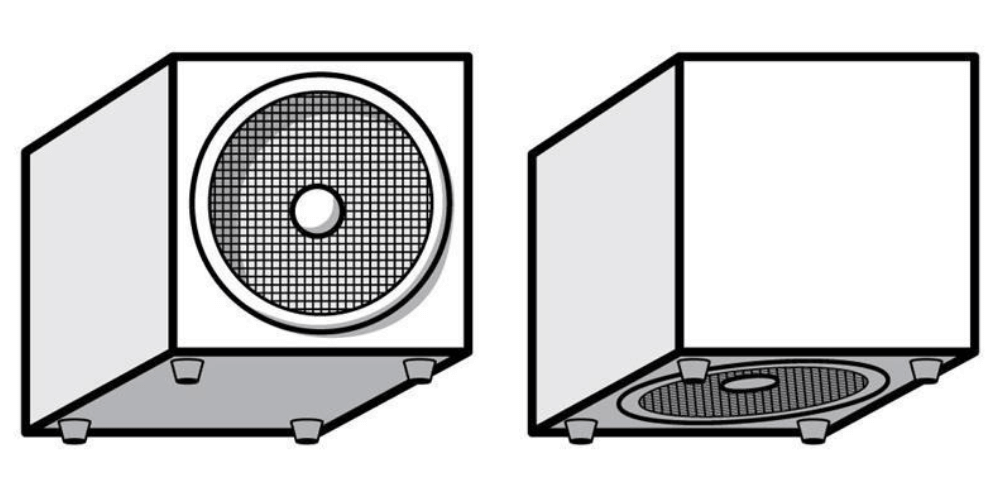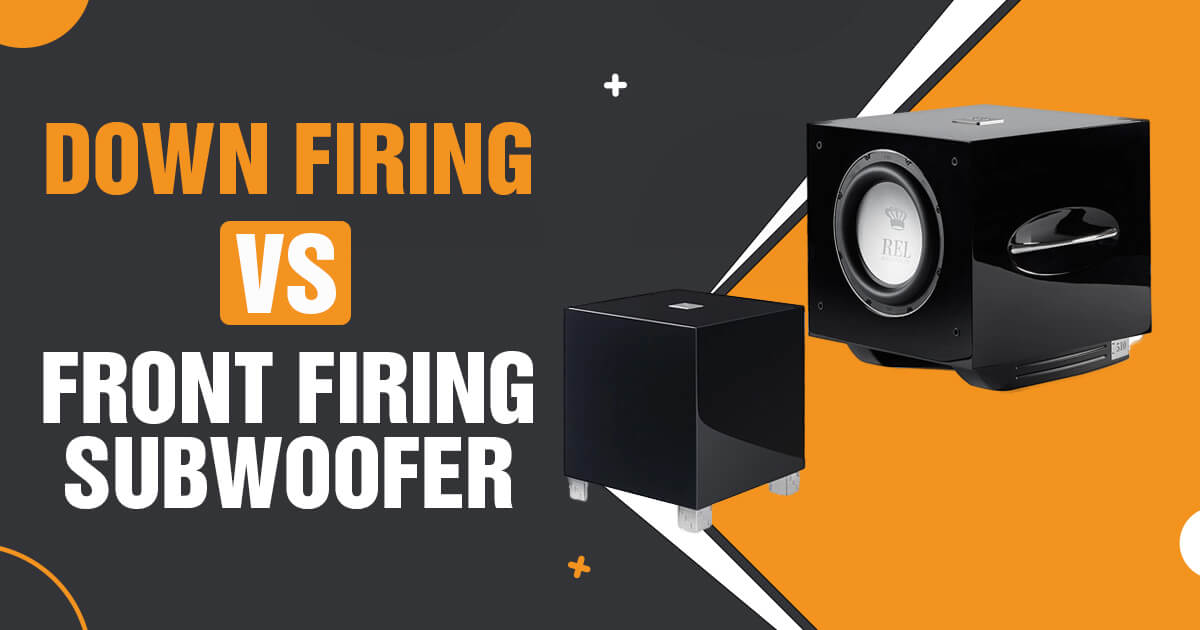Front-firing speakers emit sound in all directions, while down-firing speakers emit sound directly downward.
However, despite their different subwoofer designs, they both have the same goal: to play bass.
In many cases, it’s a question of down firing vs front firing subwoofer which is easier to set up and why you would choose one over the other.
Some people prefer the down-firing design because it’s much easier to place it in a corner or small space and then stick an inch-thick layer of foam around it.
On the other hand, many people prefer the front-firing subwoofer design because it’s more aesthetically pleasing.
However, they both have their pros and cons depending on your particular needs.
So which one should you choose? Read on to find out more about each type of speaker!
Down-Firing Subwoofer:
In comparison between down firing subwoofer vs front firing, A down-firing subwoofer is a type of speaker that faces downwards to amplify deep, low bass sounds. These subs produce enhanced bass that will make audio listening or watching movies more enjoyable.
A down-firing sub is you get a lower frequency response in your room.
These are the perfect subs for spontaneous parties.
You can get a lot of fun, but are they accurate? No, not really!
Down-firing subwoofers are the most popular type of subwoofer for home theater systems.
They are easy to install, can save space, and are less prone to picking up vibrations from the rest of the room.
The down-firing subwoofer is most commonly used to create an immersive surround sound experience, thanks to its depth perception abilities.
It disperses low-frequency sounds throughout the room instead of focusing them at one point like other types of subwoofers.
Are down firing subwoofers good?
Down-firing subwoofers can offer unique advantages such as better sound dispersion and reduced vibration, and may be a good choice for certain situations and preferences. It’s also important to consider the quality of the specific down-firing subwoofer being considered, as some models may be designed better than others and offer superior sound quality.
Overall, down-firing subwoofers can be a good choice for certain situations and preferences.
Down firing subwoofer pros and cons:
Pros:
- Better sound dispersion: Down-firing subwoofers have a unique advantage in that they project sound downwards towards the floor, which allows for better dispersion of sound throughout the room.
- Reduced vibration: The downward-facing design of the subwoofer can help to reduce vibrations on the surface it is placed on, which can improve overall sound quality and reduce the chance of disturbing other items in the room.
- Discreet appearance: The downward-facing design can make the subwoofer less noticeable in the room, as it is typically placed on the floor and can be easily disguised among other furniture.
Cons:
- Potential damage: Placing the subwoofer on the floor can increase the risk of damage from accidental bumps or kicks, as well as potential damage from pets or children.
- Limited bass response: Down-firing subwoofers may not produce as strong of a bass response as front-firing subwoofers, as the sound waves can be absorbed by the floor or surrounding objects.
- Placement limitations: The downward-facing design of the subwoofer may require specific placement in order to achieve optimal sound quality, such as placement on a hard surface or using an isolation platform to prevent vibrations from being absorbed by the floor.
Down firing vs box speaker:
Down-firing subwoofers and box speakers are two different types of audio equipment used to produce sound. Here are some key differences between the two:
- Function: Down-firing subwoofers are designed to reproduce low frequency sound (bass), while box speakers are designed to produce a full range of frequencies.
- Size: Down-firing subwoofers are generally larger and heavier than box speakers, due to the need for a larger driver to produce the low frequency sound.
- Frequency response: Down-firing subwoofers typically have a frequency response of 20 Hz to 200 Hz, while box speakers typically have a frequency response of 20 Hz to 20 kHz.
- Power handling: Down-firing subwoofers generally have a high power handling capability, while box speakers have a lower power handling capability.
- Placement: Down-firing subwoofers are often placed on the floor or in corners, while box speakers are placed on stands, shelves, or walls.
- Ideal use: Down-firing subwoofers are ideal for enhancing a home theater or music listening experience, while box speakers can be used as the main source of sound for home theater or music listening.
- Compatibility: Down-firing subwoofers can be used with speakers to enhance bass response, while box speakers can be used alone or with subwoofers for a fuller sound.
Overall, down-firing subwoofers and box speakers serve different purposes in an audio setup and their usage depends on the specific needs and preferences of the user.
Also Read: Where To Place Sub With Soundbar
Front-Firing Subwoofer:
Front-firing subs are great for bass but compromise the audio quality of the speaker.
The front-firing subwoofer includes drivers mounted to the enclosure’s front panel, giving a clear and rich sound.
However, the bass is only audible to the person sitting directly in front of the speaker.
The next closest listener hears everything clearly but lacks the bass thump that makes these speakers sound so good.
The accurate sound can also be hard to filter out with most home theater setups.
If you have a dedicated listening room, it’s probably best to use front-firing speakers for the optimum effect.
Difference Between Down Firing and Front Firing Subwoofers

When it comes to selecting a subwoofer for your home theater, there are two different types to choose from: front-firing or down-firing.
Down firing vs front firing subwoofers is a confusing and often debated topic in the audio and video production industry.
Front-firing speakers push the sound in a forward direction, whereas a down-firing speaker creates a downward flow.
Front-firing subwoofers project the sound waves upward to fire the bass off the ceiling for a more concentrated sound.
For a more immersive experience, front-firing is the best option.
Down-firing subwoofers are positioned at the floor surface or base of the speaker enclosure.
The sound waves are projected downward, which fires the bass up against the ground for a distinct. Resonant bass response.
Down-firing subwoofers are perfect for the speaker cabinet but have an array of problems.
They tend to have a lot more feedback, meaning they can reproduce sound without controlling it.
On the other hand, Front-firing subwoofers are susceptible to feedback since the sound waves move through the air instead of up.
Also Read: Is It A Good Idea To Put A Sub In A Cabinet
Front-firing subwoofers are also not ideal for smaller speakers because they can easily overpower them.
For this reason, most speakers can be mounted on a wall.
In this case, the bass will be centered above the speaker and won’t produce any audible distortion.
Down Firing Sub vs Front Firing Sub Placement
| Front-Firing | Down-Firing | |
| Driver Direction | Points sideward | Points down |
| Effect on Floor Surface | Minimal | High |
| Driver Protection | Minimal | High |
| Sag | Minimal | High |
| Sound Dispersal | Similar to conventional speakers | Pushes sound down |
| Surface Compatibility | Surface | Ground |
| Sound Masking | Less base | More base |
Driver Direction
A driver of thunderous sound waves hides within the subwoofer cabinet.
The frame, the cone, the magnet, and the coil assembly combine to amplify the low-frequency response of your music.
The speakers of the subwoofer boom and rattle as the driver vibrates and makes the cone shake, producing the sound waves we hear.
The powerful Front-firing subwoofers produce rich, deep sound by using a large, mounted speaker.
The Subwoofers amplify sound from the front or side of the cabinet, making for a more dramatic and immersive experience.
Modern down-firing subwoofers are mounted to the floor to help reproduce the low-frequency sounds and rock the house.
This is ideal for those who like to feel it deep in their chest cavity.
Effect on Floor Surface
The floor is generally considered the ideal surface to have your subwoofer, but it isn’t for everyone.
The down-firing sub produces sound waves that are dispersed directly onto the floor.
The vibrations then travel through the entire structure of the house, including the foundation and walls.
On the other hand, Front-firing subwoofers produce sound waves that bounce off the ceiling to spread through the whole room.
Front-firing subwoofers are generally considered less intrusive since they don’t make any vibrations on the floor.
Also Read: Should Your Sub Be On The Floor Or Wall
Sag
Down-firing subwoofers have the power of gravity.
They are designed to point down, so they are affected by gravity. Front-firing subwoofers have a slight sag because the driver points sideways.
This is good because it is not affected by gravity as much.
Driver Protection
Down-firing subwoofers have higher driver protection because the driver is facing inward, away from the audience.
Thus, there is less chance of toddlers or pets bumping into the cabinet.
The driver does not face outward, therefore, is buffered from any physical impact that may cause damage to the product.
Contrariwise, Front-firing subwoofers have low driver protection because the driver is facing outwards towards the audience.
Thus, there is a higher chance of kids or pets hitting the front of the cabinet, which could cause damage to it.
The subwoofer driver points outwards at the audience.
Sound Dispersal
Down-firing subwoofers direct send sound down and not to the listener.
They can be placed in the middle of a room or a hidden corner and still provide the same sound.
On the contrary, Front-firing subwoofers project sound directly at the listener.
The sound is a direct line of projection. To better natural sound, the speakers must be placed in a preferential location.
They can also be mounted directly to the wall to hide them.
Also Read: How do I stop my subwoofer from vibrating through the wall?
Surface Compatibility
Down-firing subwoofers are compatible with any floor.
They can even be placed directly on the ground, as long as a barrier separates them from the rest of the room.
On the other hand, Front-firing subs are ideal for carpeted surfaces and can be placed directly on top of the carpet to increase sound quality.
Sound Masking
Down-firing subwoofers produce more bass.
Thus, they may cause more vibrations on the wall and floors of the listening area, creating distracting sounds for others.
Contrariwise, Front-firing subwoofers generally produce less bass, which makes them ideal for homes with others present.
There will be fewer vibrations on the floor and walls, allowing others to go about their daily routines quickly.
Also Read: How To Reduce Sub Vibration Through Your Walls
Conclusion
For most people, the difference in sound quality between a front firing subwoofer and down firing subwoofer will be negligible.
Front-firing subs are better for some situations where you need to direct bass at a specific spot or if you have an open floor plan with no walls.
Down-firing subs might work best when positioned against a wall because they can evenly distribute the low end across your entire home theater space. The choice is yours!



